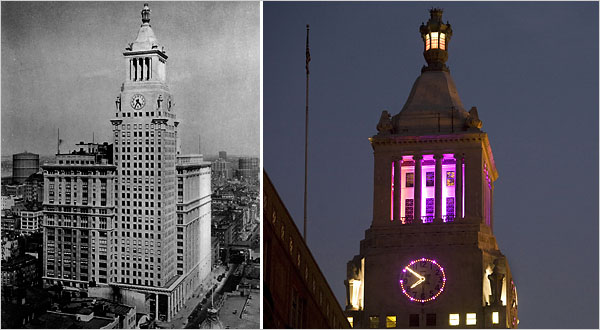|
Consolidated Edison Building
(formerly Consolidated Gas) (1910 -1929)
2-12 Irving Place, 121-147 East 14
Street, 120-140 East 15th Street
Architects: Henry Hardenbergh, Warren & Wetmore
Designated in 2009
On February 10, 2009 the Landmarks Preservation Commission voted unanimously to designate the 26-story Consolidated Edison building and tower, built in stages between 1910 and 1929, at 4 Irving Place, 121-147 E. 14th St., and 120-E. 15th St., as a city landmark.
“The Con Ed Building has a commanding presence in the Union Square neighborhood and also has one of the great towers that define the Manhattan skyline,” said Robert B. Tierney, Landmarks commissioner, at the Feb. 10 designation.
Consolidated Edison Building, 4 Irving Place, (2-12 Irving Place, 121-147 East 14
Street, 120-140 East 15th Street), Manhattan., 1910-1911, Henry Hardenbergh, architect; additions:
1912-14, Henry Hardenbergh, architect; 1926-28; Warren & Wetmore, architects, Thomas E.
Murray, Inc, engineers; 1928-29 Warren & Wetmore, architects, Thomas E. Murray, Inc, engineers.
Landmark Site: Borough of Manhattan Tax Map Block 870, Lot 24 in part, consisting of the land on
which the described building is situated, excluding the 1915 addition at 142 East 15th Street and the
parking lot to the east.
On October 28, 2008, the Landmarks Preservation Commission held a public hearing on the proposed
designation as a Landmark of the Consolidated Edison Building and the proposed designation of the related Landmark
Site (Item No. 1). The hearing had been duly advertised in accordance with the provisions of the law. A total of seven
witnesses, including a representative of the owner, City Council member Rosie Mendez, and representatives of the
Municipal Art Society, the New York Landmarks Conservancy, the Union Square Community Coalition, the Historic
Districts Council, the Metropolitan Chapter of the Victorian Society in America, and Manhattan Community Board 6
spoke in favor of the designation. There were no speakers in opposition to the designation.
The Consolidated Edison Building, constructed in
stages between 1910 and 1929 for the Consolidated Gas
Company, predecessor to Consolidated Edison, and
designed by the leading architectural firms of Henry
Hardenbergh and Warren & Wetmore, is a monumental
presence in the Union Square neighborhood and has one
of the great towers that define the Manhattan skyline.
The
earliest sections of the building, on East 15th Street and
the northern end of the block front on Irving Place, built
in two phases between 1910 and 1914, were among the
last major works of the eminent architect Henry
Hardenbergh. Hardenbergh’s eighteen-story, classically-
inspired facades feature giant segmental arches and
double-story porticos at the base and rusticated limestone
piers balanced by strong horizontal moldings at the upper
stories and are enlivened by a rich blend of Classical
Revival and Renaissance motifs. Hardenbergh also
incorporated an early and historically-significant program
of nighttime illumination in his design, which is reflected
in the presence of light sockets on the spandrel panels, soffits, upper-story window embrasures, and
crowning cornice of the 1910s wing. Between 1926 and 1929, Warren & Wetmore working in
association with the engineering firm of Thomas E. Murray built two more additions on Irving Place
and East Fourteenth Street, wrapping eighteen-story office wings, which matched the Hardenbergh-
designed portions of the building, around a signature twenty-six-story corner tower. This
monumental limestone-clad tower has a three-story colonnaded base and a setback tower featuring
illuminated clocks, a bell chamber treated as colonnaded temple modeled on the Hellenistic
Mausoleum of Halicarnassus, a bell-capped roof framed by corner obelisks, and a gigantic bronze-
and-glass lantern.
Characterized by the New Yorker as “a sturdy shaft, classic in detail and vigorous
in silhouette,” the Consolidated Edison tower won critical praise and was among the finest of
Warren & Wetmore’s late works. Dubbed the “Tower of Light” in corporate literature, the tower was
intended to be both a symbol of one of the nation’s leading producers of power and light and a
memorial to the company’s employees who had died in World War I and incorporates numerous
devices in its decorative program such as torches and burning urns appropriate for a building
associated with lighting and with funereal monuments. These dual purposes were also served by an
elaborate program of nighttime illumination, inaugurated in July 1929. Although the lighting has
been updated to reflect modern technology, the tower continues to be illuminated at night and
remains in the words of the New York Times one of the “crowns of light [that] grace the skyline” and
a symbol of Consolidated Edison, Inc. Consolidated Edison Inc. is the successor to a long line of
power and light companies, beginning with New York Gas Light Company, founded 1823, which
have played an integral role in the development of New York City. The Consolidated Edison and its
predecessors, the Consolidated Gas Company of New York and New York Edison, have
continuously been headquartered here since the building’s construction.
Source: nyc.gov, USCC
Read more:
Historic Districts Council Newsstand
A Beacon of the Changing Times
New York Times - September 12, 2008 - By Christopher Gray
back to Landmarking main page |


